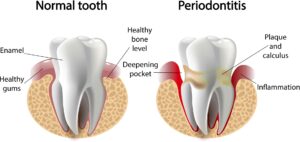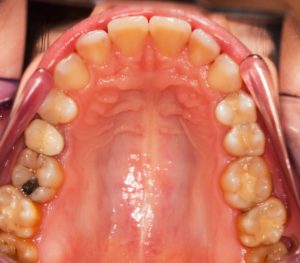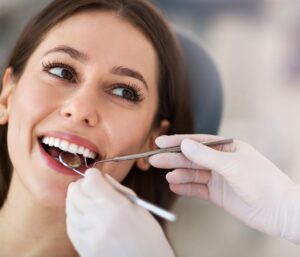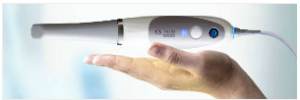Header logo
header top contact widget
Receded Gums
Dental Fear Can Be Detrimental To More Than Your Smile
Posted on Feb 15, 2024 by William J. Claiborne, DDS MS
There are varying figures on the prevalence of dental fear in the U.S. However, there is no argument that it exists and affects a rather substantial number of adults.
A 2018 study shared by Dental Products Report listed the results of a study of things that keep adults from going to the dentist. Over 60% of the 18,000 polled admitted to having dental fear. Four percent shared they had never gone to a dentist as a result.
https://www.dentalproductsreport.com/view/study-finds-more-60-percent-people-suffer-dental-fear
Another study by the Cleveland Clinic stated that about 36% of people in the U.S. have a fear of dental treatment, with 12% having an extreme fear (known as “dental phobia”).
While traumatic experiences in the past (often as a child) cause some people to be fearful of dental visits, others are not aware of why or how their fears began.
The Cleveland Clinic cites the top reasons that cause people to avoid or delay dental care are:
• Fear that the anesthetic won’t be sufficient or fear of the side effects (such as numb lips) after treatment
• Fear of bleeding during a dental procedure
• Fear gagging, choking or not being able to breathe or swallow during treatment
• Fear of dentist (often due to a bad experience in the past)
• Fear of pain
• Fear of needles
• The noise made by drills or other instruments used by the dentist or hygienist
• The smells of antiseptics or other chemicals used in a dental office
https://my.clevelandclinic.org/health/diseases/22594-dentophobia-fear-of-dentists
Having the jitters at the dental office is not all that difficult to understand. During these visits, patients are positioned on their backs on a narrow recliner with a bright light shining in their faces. Add to that having to maintain an open mouth (which is full of sensitive nerves) without really knowing what is being done. It’s not surprising that there are some uneasy feelings.
Fear or anxiety are normal reactions of the brain’s “fight or flight” response. For instance, some people have an intense fear of spiders or heights. Their reactions are automatic. Yet, in many cases of dental fear, some learn to override these reactions once they develop a sense of trust in being treated gently and respectfully.
In addition to avoiding care due to fear, some of the oral health problems we see occur from:
– Insufficient oral hygiene
– Avoiding regular dental check-ups and cleanings
– Ignoring symptoms of gum disease, such as seeing blood in the sink when brushing
– Brushing too rigorously or using abrasive substances to brush
– Age-related problems, such as oral dryness
– Oral dryness due to snoring or sinus problems
– Eating a high-carb diet or snacking frequently
– Smoking (including cigarettes, vaping, marijuana, and chew)
– Regular alcohol consumption
Certainly, some people are merely more susceptible to dental decay and bacterial buildup in the mouth. It can be due to genetics or some illnesses and diseases. Yet, the majority of reasons for having oral problems can be dealt with through proper at-home care and having regular dental exams.
When dental care is delayed or avoided due to fear, small problems that could have been prevented (or easily resolved) become big problems. Big problems require more extensive procedures, more expense and more time in treatment. When dental needs become more significant, fearful patients are actually adding to their reasons to dread the dentist.
Too, when regular dental check-ups and cleanings are avoided, the result can lead to periodontal (gum) disease, which is the nation’s leading cause of adult tooth loss. Periodontal disease occurs when an over-accumulation of oral bacteria become infectious. As it penetrates gum tissues, it also attacks the bone structures underneath the gums. This disease requires treatment that is more extensive.
Additionally, tooth loss can create an entirely new set of procedural needs and costs.
For the individual who has high anxiety or fear associated with dental visits, how are they supposed to set aside these obstacles in order to receive the dental care they need? Obviously, problems in the mouth can easily exacerbate when the signs and symptoms of gum disease are back-burnered.
At our Asheville periodontal dental office, we believe that an informed patient is a healthier patient. Understanding what the problems are and what we are doing to attend to them often helps to keep the patient involved with their oral health. It also tends to help the patient relax.
As a periodontist, I feel it’s important for every adult to know the signs and symptoms of gum disease:
Gums that bleed easily
Red, swollen, tender gums
Persistent bad breath
Gums that pull away from the teeth (recede)
Changes in the way teeth fit together when biting
Changes in the fit of partial dentures
Permanent teeth that loosen or separate
When any of these emerge, prompt treatment can minimize treatment time and costs. However, ignoring the warning signs merely allows the disease to progress further – requiring more time in treatment and greater expense.
In addition to the related problems of cavities, bad breath and tooth loss, the inflammatory bacteria of gum disease can impact overall health. Years of studies have found frightening correlations between oral bacteria and the worsening or development of serious diseases.
Research has found that the oral bacteria of gum disease (which affects over 47% of the nation’s adult population) can enter the bloodstream. Once bloodborne, this bacteria has been found to trigger inflammation that has been associated with a wide range of serious health problems. Research has shown links between these infectious bacteria to heart disease, stroke, diabetes, arthritis, some cancers, preterm babies, erectile dysfunction (ED) and even Alzheimer’s disease.
I am very proud of the relationship of trust my team and I have with our patients. They know our goal is to never cause them discomfort. Although we cannot always guarantee they’ll have no discomfort at all, we take extra steps to provide optimal comfort at every visit.
In addition to this commitment, we offer oral sedation and I.V. sedation (also referred to as “twilight sleep”).
Oral sedation is a pill that helps patients relax. It also has an amnesiac effect, leaving most with little or no memory of treatment afterward. I.V. sedation places the patient in a deeper sleep state, also erasing memory of the procedure. It is administered by a doctor of anesthesiology, overseen by Dr. Brad Stone, a Medical Doctor (MD) and a board certified Anesthesiologist & Pediatric Anesthesiologist.
https://www.biltmoreperiodontics.com/comprehensive-care-team/
With both sedation options, patients are closely monitored with advanced safety equipment throughout treatment.
If fear has prevented you from a healthy smile, schedule a consultation in our Western NC periodontal dental office. During this time, we can discuss comfort options that may be best for your individual needs. Call 828-274-9440.
Do Different Age Groups Perceive the Importance of Oral Health Differently?
Posted on Feb 09, 2024 by William J. Claiborne, DDS MS
Just how important is your oral health?
Although Americans often focus on their smiles esthetically, it’s a far more important part of you than is often given due credit on a day-to-day basis. Yes, straight, white teeth help to enhance the appearance of a smile (as well as facial appearance), it’s what is typically not seen that has far greater importance.
About 50% of the world’s population over the age of 30 suffer from periodontitis. In the U.S., a developed country with excellent healthcare, a whopping 47% of adults over the age of 30 have some level of periodontal disease.
Because gum disease can begin without obvious symptoms, or be present without having pain, it is too easily ignored. This allows the disease to progress further.
The early stage, known as gingivitis, usually begins with swollen and tender gums that bleed easily when brushing teeth. As it worsens, the healthy pink hue of gums darken to more of a red color and breath odor is persistently bad. The gums begin to loosen their strong grip around the base of teeth, allowing infectious bacteria to reach bone structures that support tooth roots. In advanced stages (periodontitis), pus pockets form near the base of some teeth and gums become spongy in texture.
The bacteria of periodontal disease doesn’t just damage oral health. Through weakened oral tissues, the bacteria can enter the bloodstream and trigger inflammatory reactions. These reactions can worsen some serious health conditions and even activate others.
Research has found correlations between these bacteria and heart disease, stroke, diabetes, arthritis, some cancers (including pancreatic), preterm babies, erectile dysfunction, and Alzheimer’s disease.
In a 2020 study, individuals with gum disease who contracted COVID-19 were 9 times more likely to die. And, the study showed that COVID patients who already had advanced gum disease were 3 times more likely to end up in intensive care or on a ventilator. Evidence shows that poor oral health can increase viral infection severity, and even fatality rates.
But, does age play a part in the commitment to oral health?
A report commissioned by Delta Dental Plans Association revealed some concerning information regarding age groups and perceptions of oral health. With over 1,000 online participants, 87% listed their priority for maintaining proper oral care was to save money or avoid unexpected expenses. Two-thirds of the group listed their commitment to at-home dental hygiene as the desire to avoid tooth decay and gum disease. Yet, only 79% of adults stated they brushed their teeth twice a day with only 33% admitting to flossing daily.
In reviewing age groups, the report found that baby boomers (those born between 1946 – 1964) understand there is a strong link between their oral and overall health, but are less aware than other generations about the connection between poor dental health and chronic diseases (such as arthritis and diabetes). Those listed in the Generation Z group (born between 1997 – 2012) showed less commitment to their oral health as the “boomers,” but are more focused on eco-friendly and nontraditional oral care products. Only 76% of Generation Z agreed that oral health is closely connected to overall health.
An article in RDH Today recently shared that one-third of millennials (born between 1981 and 1996) admit to only brushing once per day, and the average millennial has gone over two days without brushing at all. Yet, 28% of young adults admit that ““The appearance of my mouth and teeth affects my ability to interview for a job.”
The study also shared that 27% of millennials are uncomfortable going to the dentist compared to 23% of respondents 55 years and older, and 56% of millennials have simply made an excuse not to go to the dentist compared to the 36% of those 55 years and older.
While fear remains a factor in a percentage of adults, this deterrent has existed for years among all ages. The American Dental Association conducted a survey on millennials, the fear issue was not the leading problem. Cost and inconvenient time and location were cited as the top excuses for avoiding regular dental care.
Excuses aside, here are some reminders about the benefits of maintaining good oral health:
• Technology – Today’s imaging technology (such as our Cone Beam technology and IntraOral scanners), allow us to treatment plan for the most conservative treatment possible. These amazing features provide amazing detail so treatment can be performed with precision for optimal outcomes.
• Comfort – In addition to the conservative treatment made possible by advanced imaging technology, we offer enhanced comfort options, including oral and I.V. sedation. Also referred to as “twilight sleep” or “sleep dentistry,” these sedatives are administered by a doctor of anesthesia who utilizes advanced safety monitoring equipment.
• Savings of Time & Money – The reason for 6-month dental check-ups and dental cleanings is to remove tartar buildup before damage can occur. Your hygienist and dentist can look for signs of gum disease so measures can be taken before the disease explodes into the need for more costly treatment to resolve the problem. Since gum disease is the nation’s leading cause of adult tooth loss, the associated expenses of replacing teeth can also be avoided by maintaining good oral health.
• Bolstering Overall Health – Although the Covid pandemic made us more aware of the benefits of vaccines and healthy habits such as hand-washing, it is our immune system that makes people more or less vulnerable. By investing in having healthy gums, the immune system is supported.
Be aware of the signs and symptoms of gum disease. These include:
Sore, swollen gums
Gums that bleed easily when brushing
Persistent bad breath
Gums that recede (pull away or loosen from the base of teeth)
Gums that turn red in color
Pus pockets that form at the base of some teeth
Teeth that loosen or shift
If you have any of these, you are urged to seek periodontal care as soon as possible. This disease will only worsen without treatment.
Call 828-274-9440 to schedule a consultation in our state-of-the-art Asheville periodontal dental office. A referral is not required.
Sources:
https://onlinelibrary.wiley.com/doi/10.1111/jcpe.13435https://www.cdc.gov/nchs/fastats/dental.htm
https://www.todaysrdh.com/do-millennials-truly-have-worse-oral-health-than-their-parents/
https://nypost.com/2018/02/23/millennials-are-terrible-at-keeping-their-teeth-clean/
A Periodontist Can Contour Gum Tissues For A More Beautiful Smile
Posted on Nov 23, 2023 by William J. Claiborne, DDS MS
During the holidays, my wife and I attend gatherings where we occasionally meet new people. A common question, as applies to most of us, is “What do you do?” When I reply that I’m a periodontist, it is often met with a look of not knowing what a periodontist is but not wanting to appear as if that’s the case.
I’d like to explain what “we” are and, from a smile enhancement basis, what we can provide. I typically find that when I say “periodontal plastic surgery” it comes across as far more familiar than “performing gingivectomies.”
A periodontist is a dental specialist who has an advanced level of understanding when it comes to diseases of the oral tissues, reshaping of gum tissues and in the selection and placement of dental implants.
The American Academy of Periodontology defines a Periodontist as:
“A periodontist is a dentist who specializes in the prevention, diagnosis, and treatment of periodontal disease, and in the placement of dental implants. Periodontists are also experts in the treatment of oral inflammation. Periodontists receive extensive training in these areas, including three additional years of education beyond dental school. They are familiar with the latest techniques for diagnosing and treating periodontal disease, and are also trained in performing cosmetic periodontal procedures.”
https://www.perio.org/consumer/what-is-a-periodontist
To reach this specialty begins with educational requirements that are extensive. First, there is completion of 4 years of college (for an undergraduate degree) followed by another 4 years in dental school (for a doctorate). To specialize in Periodontics, he or she must further their education for another 3-4 years before completing the stringent requirements for specialty certification in periodontics.
The gums are rather under-rated when it comes to the tremendous role they play in both oral health and even your overall health.
Think of the gum tissues as a protective blanket in the mouth. The gums cover over the structures that support teeth and house the tissues and bone that are vital to our health. For instance, look at the base of each tooth. You’ll see that gum tissues snugly wrap around the base of each tooth. This protective seal is what prevents bacterial penetration beneath the gum line.
When oral bacteria amass to an extent that cannot be controlled by oral hygiene measures at home, they cause inflammation in the gums. In turn, the gums loosen their tight grip around teeth, which allows entry of the now-potent bacteria. These infectious bacteria have been linked to a number of problems related to a long list of serious health problems.
Oral bacteria has been found to trigger or worsen systemic conditions, including atherosclerotic vascular (heart) disease, pulmonary (respiratory) disease, diabetes, pregnancy-related complications (including preterm births), osteoporosis (bone loss), and kidney disease. A shared trait between gum disease and these medical conditions is that they are chronic conditions that take a long time to develop.
https://www.agd.org/docs/default-source/self-instruction-(gendent)/gendent_nd17_aafp_kane.pdf
It is important to be familiar with the signs and symptoms of periodontal (gum) disease, which include:
• Red, swollen or tender gums
• Bleeding while brushing, flossing, or when eating certain foods
• Gums that pull away from the teeth (recede) or make the teeth appear longer than normal
• Loose or separating teeth
• Pus pockets that form between gums and teeth
• Sores in your mouth
• Persistent bad breath
• A change in the way teeth fit together when biting
• A change in the fit of partial dentures
If you have any of these, you are urged to seek a thorough periodontal evaluation as soon as possible. This disease will only worsen without treatment. Gum disease is the nation’s leading cause of adult tooth loss.
Healthy gum tissues do more than serve in a protective role. The appearance of a smile can be greatly affected by the shape and amount of gum tissues exposed when smiling.
When a smile shows too much or too little gum tissue bordering the tops of teeth, it moves the “smile line” out of balance. For example, in a beautiful smile, the arches of gum tissues visible in a full smile flow at a similar height. These gum arches are in a complimentary line to teeth, rather than at varying levels over teeth. When the gum lime is not evenly balanced, it causes a smile to have a jumbled look.
Crown lengthening is performed to reposition the gum tissues to enhance the appearance of a smile. In addition to creating a more appealing look, crown lengthening is also performed to restore the tight seal of protection around teeth. While you enjoy the beauty of your new smile, crown lengthening gives your oral health a boost at the same time.
When the height of gum tissues that show above all teeth in a smile is too high, it is referred to as a “gummy smile.” A gummy smile is not detrimental to your oral health. However, having one does affect the appearance of a smile based on balance. For some people, it makes them “hold back” on a full smile.
This can be corrected with a gingivectomy. To begin, we numb the gum tissues and carefully trim the excess. As a Periodontist, I take specific measures to ensure a natural looking arch remains over the teeth while preserving the natural points that ‘dip’ between each tooth.
 A gingivectomy is performed in our Asheville periodontal office with a dental laser. This provides patients with a number of advantages: (1) enhanced comfort; (2) precision lines; (3) minimal or no bleeding; and, (4) faster healing time.
A gingivectomy is performed in our Asheville periodontal office with a dental laser. This provides patients with a number of advantages: (1) enhanced comfort; (2) precision lines; (3) minimal or no bleeding; and, (4) faster healing time.
In our Asheville NC periodontal office, we use the highly-advanced LANAP with PerioLase MVP 7 Laser-Assisted Attachment Procedure. This is an advanced protocol that efficiently and effectively treats advanced gum disease (periodontitis) with the added advantages of a dental laser. It is a non-surgical alternative for patients with moderate to severe periodontal disease, causes very little discomfort and has a quick recovery time. It has also been found to stimulate bone regrowth in damaged areas.
In some cases, the crown lengthening procedure can save a tooth from removal. Typically, when a tooth fractures or breaks at the gum line, it must be removed since there is not enough tooth structure to support a crown. However, a crown lengthening procedure may be able to expose more of the tooth’s structure, essentially saving the natural tooth.
For those who have avoided gum treatment due to dental fear, we offer several sedation options, including oral and IV sedation. Oral sedation is a pill that helps patients relax. It also has an amnesiac effect, leaving most with little or no memory of treatment afterward.
I.V. sedation (also known as “twilight sleep”) places the patient in a deeper sleep state and erases memory of the procedure. Here, anesthesia is overseen by a medical doctor (MD) who is a board certified Anesthesiologist. With both sedation options, patients are closely monitored with advanced safety equipment throughout treatment.
We help patients understand that their fears and concerns are not unusual. The doctors and staff of our Asheville periodontal dental office respect each patient and provide gentle, compassionate care – at every appointment.
We believe you’ll find no better periodontal dental environment in western NC. Whatever your need for the treatment of gum disease, recontouring of gum tissues, or in the placement of dental implants, call 828-274-9440 to learn more or to schedule a consultation appointment. New patients are always welcome and a referral is not required.
Laser Dentistry, Cone Beam Imaging Among Our Advanced Features!
Posted on Nov 15, 2023 by William J. Claiborne, DDS MS
Like your “adult” teeth, your gum tissues are irreplaceable. Without question, they deserve the care and attention that come with keeping them healthy and doing their job.
Gum tissues are designed to protect the structures underneath. These include bones, tooth roots, tendons, and muscles to prevent entry of harmful bacteria. Gums are designed to snugly wrap the base of each tooth to keep bacteria from penetrating sensitive root segments of teeth.
Without this protective seal around teeth, the potential for periodontal (gum) disease greatly increases. And gum disease is at concerningly high levels in the U.S. with an estimated 47% of adults having some level of gum disease.
I believe that this high level of gum disease is largely in part due to Americans not being fully familiar with the symptoms. Some are easily ignored or “brushed off” as normal. This is why it is important to be familiar with the signs and symptoms, which include:
• Red, swollen or tender gums or other pain in your mouth
• Bleeding while brushing, flossing, or when eating certain foods
• Gums that pulling away from the base of teeth, making them appear teeth longer
• Loose or separating teeth
• Pus between your gums and teeth
• Sores in your mouth
• Persistent bad breath
• A change in the way your teeth fit together when biting
• A change in the fit of partial dentures
If you are experiencing any of these symptoms, you are urged to seek care with a periodontal specialist as soon as possible. This disease will only worsen without treatment.
Why should you be concerned about periodontal disease?
Gum disease is the nation’s leading cause of adult tooth loss. Additionally, research has linked the bacteria of periodontitis with serious health problems. These include heart disease, stroke, arthritis, diabetes, some cancers, preterm babies, erectile dysfunction (ED) and high blood pressure. Studies on links to Alzheimer’s disease are showing concerning correlations.
A periodontist is an expert in the treatment of all stages of gum disease, including gingivitis, periodontal disease, and the advanced form of periodontitis.
In addition to having these specific skills, I’d like to share the benefits of some of our amazing technology we make available to our Western NC patients. One with a wide range of benefits to patient care is our Dental Laser.
Nd: YAG Dental Laser: This is a small, hand-held device that eliminates or greatly minimizes bleeding during procedures. It also reduces numbing requirements, removes bacteria and easily uncovers gum tissue where dental implants have been placed.
Additionally, laser dentistry can quickly repair oral ulcers and beautifully re-contours or repairs gum tissue with a precision line. Some specific treatments that are ideal for a dental laser include:
Canker & Cold Sores: The laser is also ideal for rapid healing of canker and cold sores. Laser therapy can halt the progression of canker sores, reducing the pain in a day or so. Otherwise, they can last up to 2 weeks. When it comes to cold sores, they are best treated with our laser when the very first symptom arises. Tingling or burning sensation is the first sign that a cold sore is about to erupt. Although lasers can still treat these lesions in later stages, the treatment is most effective in initial stages. Most patients notice significant improvement in comfort after laser treatment with a much shorter duration.
Gum Disease Treatment: In our office, we also use a dental laser to destroy the bacteria of gum disease. This technology also speeds the process and heightens your comfort, saving you treatment time with faster healing.
Correcting a “Gummy Smile”: This is when a smile shows too much gum tissue above upper teeth when smiling fully. We correct this in a procedure known as crown lengthening. In this, a gingivectomy adjusts the height of gum tissues so the smile has a more even smile line. This may involve the use of a dental laser, which provides a precision line and speeds healing.
Balancing a smile line: A gingivectomy is also advised to rebalance the frame of gum tissues that arch the teeth visible in a smile. When one or two teeth have different heights of gum tissue, the smile has a jumbled look. A dental laser can even out the smile line and enhance the beauty of a smile.
Saving a tooth broken near the gum line: When a tooth breaks at or near the gum line, it often requires removal. In some cases, however, we can save the tooth by exposing enough of the structure to receive a crown. This helps the patient to avoid removal and thereby preserves the supporting jaw bone.
In our Asheville NC periodontal dental office, we feature additional technologies, some of the most advanced in the industry. These include:
LANAP Protocol Using PerioLase MVP-7: This process is designed to efficiently and effectively treat periodontitis (advanced gum disease) through laser technology. Treatment is administered with minimal (or no) discomfort and recovery time is minimal. Amazingly, this technology has also been able to stimulate bone regrowth in damaged areas.
Cone Beam 3D Imaging: These views allow us to see your jaw in 3D dimensions and to be able to view it at varying angles. This enables us to see what used to be hidden from view.
Cone Beam images are often used to assess:
• Dental Implant Positions
• Temporomandibular Joints (TMJ)
• Airway Passages
• Bone Structure Damage or Bone Loss
• Teeth, Tooth Roots and Facial Structures
• Signs Of Infections, Cysts, Or Tumors
CS 3600 Intraoral Scanner: Through this process, our patient no longer have impressions made with bulky, goopy trays held in their mouths. This technology quickly and comfortably scans the mouth’s interior for digital impressions using a small, handheld scanner. It can also reach difficult–to–access areas in the patient’s mouth with improved patient comfort.
Simplant Dental Software for Computerized Dental Implant Placement: This system helps in pre-surgical positioning of dental implants on the computer, using a 3D model of the patient’s jaw. This aids in the selection of the implant type to ensure a precision fit.
Intraoral Camera Technology: This provides outstanding quality of images within the mouth. These images are sent to screen for a clear, crisp view so we can confer with patients on specific treatment needs.
Computer Imaging In Treatment Suites: Treatment suites are equipped with computers for convenient image sharing with patients.
Oral & IV Sedation: We take patient comfort very seriously in our Asheville periodontal dental office. That’s a commitment we make to every patient at every appointment. Here, patient comfort is supported by our sedation options. These include oral and I.V. sedation. Also referred to as “twilight sleep” or “sleep dentistry,” these sedatives are administered by a highly-skilled anesthesiologist who uses advanced safety monitoring equipment throughout the patient’s procedure.
My staff and I also take great pride in providing patients with an environment of respect. Some adults come to us embarrassed by the condition of their oral health or missing teeth. Here, we strive to make patients feel they are in the right hands in the right place.
If tooth loss has occurred, a periodontist also specializes in the selection and placement of all types of dental implants. Dental implants, for many reasons, are the preferred option for tooth replacement.
Call 828-274-9440 to schedule a consultation in our state-of-the-art Asheville periodontal dental office. New patients are always welcome and a referral is not always necessary.
Recent Posts
Categories
Archives
- September 2024
- August 2024
- July 2024
- June 2024
- May 2024
- April 2024
- March 2024
- February 2024
- January 2024
- December 2023
- November 2023
- October 2023
- September 2023
- August 2023
- July 2023
- June 2023
- May 2023
- April 2023
- March 2023
- February 2023
- January 2023
- December 2022
- November 2022
- October 2022
- September 2022
- August 2022
- July 2022
- June 2022
- May 2022
- April 2022
- March 2022
- February 2022
- January 2022
- December 2021
- November 2021
- October 2021
- September 2021
- August 2021
- July 2021
- June 2021
- May 2021
- April 2021
- March 2021
- February 2021
- January 2021
- December 2020
- November 2020
- October 2020
- September 2020
- August 2020
- July 2020
- June 2020
- May 2020
- April 2020
- March 2020
- February 2020
- January 2020
- December 2019
- November 2019
- October 2019
- September 2019
- August 2019
- July 2019
- June 2019
- May 2019
- April 2019
- March 2019
- February 2019
- January 2019
- December 2018
- November 2018
- October 2018
- September 2018
- August 2018
- July 2018
- June 2018
- May 2018
- April 2018
- March 2018
- February 2018
- January 2018
- December 2017
- November 2017
- October 2017
- September 2017
- August 2017
- July 2017
- June 2017
- May 2017
- April 2017
- March 2017
- February 2017
- January 2017
- December 2016
- November 2016
- October 2016
- September 2016
- August 2016
- July 2016
- June 2016
- May 2016
- April 2016
- March 2016
- February 2016
- January 2016
- December 2015
- November 2015
- October 2015
- September 2015
- August 2015
- July 2015
- June 2015
- May 2015
- April 2015
- March 2015
- February 2015
- January 2015
- December 2014
- November 2014
- October 2014
- September 2014
- August 2014
- July 2014
- June 2014
- May 2014
- April 2014
- March 2014
- February 2014
- January 2014
- December 2013
- November 2013
- October 2013
- September 2013
- August 2013
- July 2013
- June 2013
- May 2013
- April 2013
- March 2013
- February 2013
- January 2013
- December 2012
- November 2012
- October 2012
- September 2012
- August 2012
- July 2012
- June 2012


